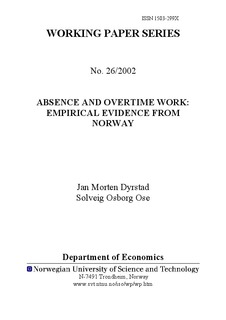| dc.contributor.author | Dyrstad, Jan Morten | nb_NO |
| dc.contributor.author | Ose, Solveig Osborg | nb_NO |
| dc.date.accessioned | 2014-12-19T14:31:56Z | |
| dc.date.available | 2014-12-19T14:31:56Z | |
| dc.date.created | 2006-10-03 | nb_NO |
| dc.date.issued | 2002 | nb_NO |
| dc.identifier | 126112 | nb_NO |
| dc.identifier.uri | http://hdl.handle.net/11250/267155 | |
| dc.description.abstract | This paper presents both theoretical and empirical analyses of the relationship between overtime work and absence. Demand for absence is analysed under the assumption that workers in a given firm can be represented by one of two types of workers, denoted overemployed and underemployed. Increased demand for overtime hours has a nonpositive effect on absence. If actual overtime pay is higher than the reservation wage, a higher demand for overtime hours will reduce absence. Otherwise absence is unaffected. On the other hand, demand for overtime increases if absence increases. The empirical analysis is carried out on quarterly panel data from 263 firms, covering the time period 1990-96. The empirical results confirm the theoretical predictions except from the effect of overtime hours on absence, where positive elasticities are estimated. | nb_NO |
| dc.language | eng | nb_NO |
| dc.publisher | Institutt for samfunnsøkonomi | nb_NO |
| dc.relation.ispartofseries | Working Paper Series, 1503-299X; 2001:26 | nb_NO |
| dc.title | Absence and Overtime Work: Empirical Evidence from Norway | nb_NO |
| dc.type | Research report | nb_NO |
| dc.contributor.department | Norges teknisk-naturvitenskapelige universitet, Fakultet for samfunnsvitenskap og teknologiledelse, Institutt for samfunnsøkonomi | nb_NO |
